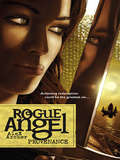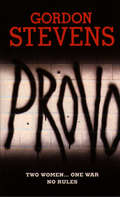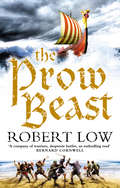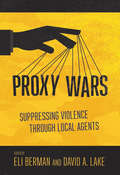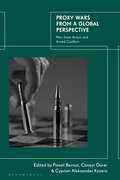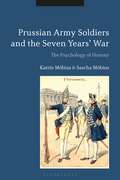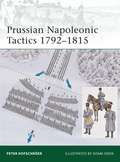- Table View
- List View
The Prow Beast (The Oathsworn Series #4)
by Robert LowThe epic and action packed fourth novel in the Oathsworn series, charting the adventures of Orm and his band of Viking brothers.
Proxy War: The Least Bad Option
by Tyrone L. GrohThe U.S. has indirectly intervened in international conflicts on a relatively large scale for decades. Yet little is known about the immediate usefulness or long-term effectiveness of contemporary proxy warfare. In cases when neither direct involvement nor total disengagement are viable, proxy warfare is often the best option, or, rather, the least bad option. Tyrone L. Groh describes the hazards and undesirable aspects of this strategy, as well as how to deploy it effectively. Proxy War explores the circumstances under which indirect warfare works best, how to evaluate it as a policy option, and the possible risks and rewards. Groh offers a fresh look at this strategy, using uncommon and understudied cases to test the concepts presented. These ten case studies investigate and illustrate the different types and uses of proxy war under varying conditions. What arises is a complete theoretical model of proxy warfare that can be applied to a wide range of situations. Proxy war is here to stay and will likely become more common as players on the international stage increasingly challenge U.S. dominance, making it more important than ever to understand how and when to deploy it.
Proxy War in Yemen (Cass Military Studies)
by Bernd Kaussler Keith A. GrantThis book analyzes the civil war in Yemen and how intervening external actors have shaped the trajectory of the conflict. The work examines the conflict in Yemen as a testing ground for expectations about the autonomy and control of proxies by external patrons and the direct consequences for civilian victimization and duration of war. Like other proxy wars, the international dimensions of the war made the conflict in Yemen subject to the geopolitical interests of intervening powers. The longstanding power rivalry between Saudi Arabia and Iran over Middle East supremacy resulted in a competitive intervention in Yemen, where the initial belligerents of the civil war—the Houthi and the Hadi regime—were used as proxies by Tehran and the Gulf coalition led by Riyadh, respectively. Their intervention ultimately translated into a prolonged and destructive conflict. The often contradictory and self-interested patronage strategies by the coalition’s two central patrons, Saudi Arabia and the United Arab Emirates, undermined their broader goal of containing Iran. However, Iran’s support for the Houthis enabled them to bait and bleed the Gulf coalition. Lastly, in an effort to balance against Iran, the United States underwrote the military campaign of the Gulf states with military hardware and personnel, thereby further prolonging the conflict and humanitarian disaster. This book concludes that intervention by external patrons both protracted the civil war and made it far more destructive for the civilian population. This book will be of much interest to students of proxy wars, Middle Eastern conflict, and security studies in general.
Proxy War in Yemen (Cass Military Studies)
by Bernd Kaussler Keith A. GrantThis book analyzes the civil war in Yemen and how intervening external actors have shaped the trajectory of the conflict. The work examines the conflict in Yemen as a testing ground for expectations about the autonomy and control of proxies by external patrons and the direct consequences for civilian victimization and duration of war. Like other proxy wars, the international dimensions of the war made the conflict in Yemen subject to the geopolitical interests of intervening powers. The longstanding power rivalry between Saudi Arabia and Iran over Middle East supremacy resulted in a competitive intervention in Yemen, where the initial belligerents of the civil war—the Houthi and the Hadi regime—were used as proxies by Tehran and the Gulf coalition led by Riyadh, respectively. Their intervention ultimately translated into a prolonged and destructive conflict. The often contradictory and self-interested patronage strategies by the coalition’s two central patrons, Saudi Arabia and the United Arab Emirates, undermined their broader goal of containing Iran. However, Iran’s support for the Houthis enabled them to bait and bleed the Gulf coalition. Lastly, in an effort to balance against Iran, the United States underwrote the military campaign of the Gulf states with military hardware and personnel, thereby further prolonging the conflict and humanitarian disaster. This book concludes that intervention by external patrons both protracted the civil war and made it far more destructive for the civilian population. This book will be of much interest to students of proxy wars, Middle Eastern conflict, and security studies in general.
Proxy Wars: Suppressing Violence through Local Agents
The most common image of world politics involves states negotiating, cooperating, or sometimes fighting with one another; billiard balls in motion on a global pool table. Yet working through local proxies or agents, through what Eli Berman and David A. Lake call a strategy of "indirect control," has always been a central tool of foreign policy. Understanding how countries motivate local allies to act in sometimes costly ways, and when and how that strategy succeeds, is essential to effective foreign policy in today's world. In this splendid collection, Berman and Lake apply a variant of principal-agent theory in which the alignment of interests or objectives between a powerful state and a local proxy is central. Through analysis of nine detailed cases, Proxy Wars finds that: when principals use rewards and punishments tailored to the agent's domestic politics, proxies typically comply with their wishes; when the threat to the principal or the costs to the agent increase, the principal responds with higher-powered incentives and the proxy responds with greater effort; if interests diverge too much, the principal must either take direct action or admit that indirect control is unworkable. Covering events from Denmark under the Nazis to the Korean War to contemporary Afghanistan, and much in between, the chapters in Proxy Wars engage many disciplines and will suit classes taught in political science, economics, international relations, security studies, and much more.
Proxy Wars from a Global Perspective: Non-State Actors and Armed Conflicts
by Paweł Bernat, Cüneyt Gürer, Cyprian Aleksander KozeraProxy warfare is a growing international phenomenon. Although states have used proxies in armed conflicts for centuries, evolving regional and global security architecture is now forcing states to radically change the way contemporary conflicts are fought. Based on ten case studies, this reassesses exactly how these changing global and systemic factors are shaping the ways in which states use non-state actors as proxies in their armed conflicts. Examining the use of proxy warfare worldwide, focusing on the last decade's conflicts, this volume brings together contributions from scholars of international relations and global security studies in order to explore cases of armed conflict of particular regional and global significance. These include recent developments in the conflict in Israel and Palestine, the Central African Republic, Libya, Mali, Central Asia, Syria, Ukraine, Nagorno-Karabakh, Brazil and Yemen. By drawing on both theory and practise, it offers a re-evaluation of contemporary understanding of "outsourced warfare", with policy implications for how we understand and negotiate with states using proxy warfare in the future.
Proxy Wars from a Global Perspective: Non-State Actors and Armed Conflicts
Proxy warfare is a growing international phenomenon. Although states have used proxies in armed conflicts for centuries, evolving regional and global security architecture is now forcing states to radically change the way contemporary conflicts are fought. Based on ten case studies, this reassesses exactly how these changing global and systemic factors are shaping the ways in which states use non-state actors as proxies in their armed conflicts. Examining the use of proxy warfare worldwide, focusing on the last decade's conflicts, this volume brings together contributions from scholars of international relations and global security studies in order to explore cases of armed conflict of particular regional and global significance. These include recent developments in the conflict in Israel and Palestine, the Central African Republic, Libya, Mali, Central Asia, Syria, Ukraine, Nagorno-Karabakh, Brazil and Yemen. By drawing on both theory and practise, it offers a re-evaluation of contemporary understanding of "outsourced warfare", with policy implications for how we understand and negotiate with states using proxy warfare in the future.
The Prussian Army of the Lower Rhine 1815 (Men-at-Arms)
by Gerry Embleton Peter HofschröerThe Prussian Army of the Lower Rhine, led by Blücher in 1815, played a crucial part in the Allied victory at Waterloo, and was involved in intense fighting at Wavre and Ligny. Delving into original sources, including eyewitness accounts and regimental histories known only to German scholars, this book tells the story of the soldiers on the ground: how they were organised and drilled, their previous service; their march to the battlefield; and what they did when they got there. Also ideal for all those interested in the actual appearance of the Prussian soldiers in 1815, this colourful study combines the latest findings and expert analysis to cast new light on the fateful Waterloo campaign.
The Prussian Army of the Lower Rhine 1815 (Men-at-Arms #496)
by Gerry Embleton Peter HofschröerThe Prussian Army of the Lower Rhine, led by Blücher in 1815, played a crucial part in the Allied victory at Waterloo, and was involved in intense fighting at Wavre and Ligny. Delving into original sources, including eyewitness accounts and regimental histories known only to German scholars, this book tells the story of the soldiers on the ground: how they were organised and drilled, their previous service; their march to the battlefield; and what they did when they got there. Also ideal for all those interested in the actual appearance of the Prussian soldiers in 1815, this colourful study combines the latest findings and expert analysis to cast new light on the fateful Waterloo campaign.
Prussian Army Soldiers and the Seven Years' War: The Psychology of Honour
by Katrin Möbius Sascha MöbiusThe army of Frederick the Great of Prussia is generally known as an efficient fighting machine based on brutal and strict drill procedures that led to broken but fearless soldiers as well as glorious battle victories. In analysing the mentalities of the men who established Prussia's great power status, Prussian Army Soldiers and the Seven Years' War fundamentally challenges this interpretation.Drawing on a vast array of primary sources (including the writing of regimental chaplain Küster, who could probably be called the first modern military psychologist) and presenting the first English translation of 12 letters of common Prussian soldiers from the Seven Years' War, this book shows that the soldiers were feeling individuals. They were loving husbands, vulnerable little brothers, deeply religious preachers, and sometimes even bold adventurers. All these individuals, however, were united by one idea which made them fight efficiently: honour. In Prussian Army Soldiers and the Seven Years' War, the different elements of the Prussian soldiers' concept of such honour are expertly analysed. The result is a nuanced, sophisticated, and much-needed psychological history of Frederick the Great's army.
Prussian Army Soldiers and the Seven Years' War: The Psychology of Honour
by Katrin Möbius Sascha MöbiusThe army of Frederick the Great of Prussia is generally known as an efficient fighting machine based on brutal and strict drill procedures that led to broken but fearless soldiers as well as glorious battle victories. In analysing the mentalities of the men who established Prussia's great power status, Prussian Army Soldiers and the Seven Years' War fundamentally challenges this interpretation.Drawing on a vast array of primary sources (including the writing of regimental chaplain Küster, who could probably be called the first modern military psychologist) and presenting the first English translation of 12 letters of common Prussian soldiers from the Seven Years' War, this book shows that the soldiers were feeling individuals. They were loving husbands, vulnerable little brothers, deeply religious preachers, and sometimes even bold adventurers. All these individuals, however, were united by one idea which made them fight efficiently: honour. In Prussian Army Soldiers and the Seven Years' War, the different elements of the Prussian soldiers' concept of such honour are expertly analysed. The result is a nuanced, sophisticated, and much-needed psychological history of Frederick the Great's army.
Prussian Cavalry of the Napoleonic Wars: 1807–15 (Men-at-Arms)
by Peter Hofschröer Bryan FostenAfter Prussia's dismemberment a drastic re-organisation of the entire army was necessary, and the cavalry underwent this process with the rest. At the time of the mobilisation in 1813, the somewhat reduced mounted arm was supplemented by voluntary and militia formations; and once peace was established after the First Abdication, a further re-organisation was begun. The fateful campaign of 1815 was fought with the Prussian cavalry still in the throes of this re-organisation. Packed with diagrams, illustrations and eight full page colour plates by Bryan Fosten, this book by Peter Hofschröer details the history, organisation, equipment and uniforms of the Prussian cavalry which fought in the Napoleonic wars.
Prussian Cavalry of the Napoleonic Wars: 1792–1807 (Men-at-Arms)
by Peter Hofschröer Bryan FostenWhen Frederick II (later known as Frederick the Great) came to the throne in 1740, he had three advantages for which he owed thanks to his father: a modern, well-organised state; full coffers; and a properly trained and equipped army. Under a leader as renowned as Seydlitz, the Prussian cavalry achieved the nearest to a state of perfection that it was ever going to. So great was its reputation in the Seven Years' War that Napoleon made a special point of warning his men at the beginning of the 1806 campaign to beware of the Prussian cavalry.
Prussian Cavalry of the Napoleonic Wars: 1792–1807 (Men-at-Arms)
by Peter Hofschröer Bryan FostenWhen Frederick II (later known as Frederick the Great) came to the throne in 1740, he had three advantages for which he owed thanks to his father: a modern, well-organised state; full coffers; and a properly trained and equipped army. Under a leader as renowned as Seydlitz, the Prussian cavalry achieved the nearest to a state of perfection that it was ever going to. So great was its reputation in the Seven Years' War that Napoleon made a special point of warning his men at the beginning of the 1806 campaign to beware of the Prussian cavalry.
Prussian Cavalry of the Napoleonic Wars: 1807–15 (Men-at-Arms #172)
by Peter Hofschröer Bryan FostenAfter Prussia's dismemberment a drastic re-organisation of the entire army was necessary, and the cavalry underwent this process with the rest. At the time of the mobilisation in 1813, the somewhat reduced mounted arm was supplemented by voluntary and militia formations; and once peace was established after the First Abdication, a further re-organisation was begun. The fateful campaign of 1815 was fought with the Prussian cavalry still in the throes of this re-organisation. Packed with diagrams, illustrations and eight full page colour plates by Bryan Fosten, this book by Peter Hofschröer details the history, organisation, equipment and uniforms of the Prussian cavalry which fought in the Napoleonic wars.
Prussian Light Infantry 1792–1815 (Men-at-Arms #149)
by Peter Hofschröer Bryan FostenThe Prussian light infantry branch was founded in the reign of Frederick the Great (1740-1786) and continued to develop from then onwards. It was the light troops of the Austrian army, the Croatian border soldiers, which so impressed Frederick in the Seven Years War that he considered it necessary to create an effective counter-force. Initially, there was a degree of reluctance amongst certain sections of the army towards this formation of light infantry. However, the Fusilier Battalions came to be regarded as elite formations, being well-trained, disciplined and carefully selected men led by young, fit and intelligent officers. This book described in detail the uniforms, organisation, training and weapons of this spectacular force.
Prussian Light Infantry 1792–1815 (Men-at-Arms)
by Peter Hofschröer Bryan FostenThe Prussian light infantry branch was founded in the reign of Frederick the Great (1740-1786) and continued to develop from then onwards. It was the light troops of the Austrian army, the Croatian border soldiers, which so impressed Frederick in the Seven Years War that he considered it necessary to create an effective counter-force. Initially, there was a degree of reluctance amongst certain sections of the army towards this formation of light infantry. However, the Fusilier Battalions came to be regarded as elite formations, being well-trained, disciplined and carefully selected men led by young, fit and intelligent officers. This book described in detail the uniforms, organisation, training and weapons of this spectacular force.
Prussian Line Infantry 1792–1815 (Men-at-Arms)
by Peter Hofschröer Bryan FostenAt the beginning of this period, the battalions of the Prussian Line usually fought in a linear formation three ranks deep, overwhelming the enemy with fire before a well-timed bayonet attack. By the end, the preferred formation was eight to 12 ranks deep. The responsibility for conducting the fire-fight was now given to the skirmish elements and the artillery. The formed battalions provided support for the fire line, and conducted the decisive bayonet charge. Whatever the change, the spirit and ability of the infantry remained consistently high throughout this bloody period.
Prussian Line Infantry 1792–1815 (Men-at-Arms)
by Peter Hofschröer Bryan FostenAt the beginning of this period, the battalions of the Prussian Line usually fought in a linear formation three ranks deep, overwhelming the enemy with fire before a well-timed bayonet attack. By the end, the preferred formation was eight to 12 ranks deep. The responsibility for conducting the fire-fight was now given to the skirmish elements and the artillery. The formed battalions provided support for the fire line, and conducted the decisive bayonet charge. Whatever the change, the spirit and ability of the infantry remained consistently high throughout this bloody period.
Prussian Napoleonic Tactics 1792–1815 (Elite #182)
by Peter HofschröerWritten by an expert on the Prussian army of the Napoleonic era, this is a fascinating insight into the 18th-century evolution of the Prussian forces into the war-winning troops of the final battles against Napoleon. Using contemporary materials including drill regulations, instructions, staff and regimental histories and after-action reports, this book provides a compelling history of Prussian tactics from 1792 until 1815. It includes studies of the professional Prussian army during the Revolutionary Wars and the mass mobilization of a conscript army that fought during the Wars of Liberation and Waterloo. Following on from the success of Osprey's other Elite Tactics volumes, this is a must-have for serious students of Napoleonic warfare, armchair generals, and wargamers alike.
Prussian Napoleonic Tactics 1792–1815 (Elite)
by Adam Hook Peter HofschröerWritten by an expert on the Prussian army of the Napoleonic era, this is a fascinating insight into the 18th-century evolution of the Prussian forces into the war-winning troops of the final battles against Napoleon. Using contemporary materials including drill regulations, instructions, staff and regimental histories and after-action reports, this book provides a compelling history of Prussian tactics from 1792 until 1815. It includes studies of the professional Prussian army during the Revolutionary Wars and the mass mobilization of a conscript army that fought during the Wars of Liberation and Waterloo. Following on from the success of Osprey's other Elite Tactics volumes, this is a must-have for serious students of Napoleonic warfare, armchair generals, and wargamers alike.
Prussian Reserve, Militia & Irregular Troops 1806–15 (Men-at-Arms #192)
by Peter Hofschröer Bryan FostenIrregular, semi-regular and reserve formations comprised a substantial part of the armed forces at the disposal of the Prussian Army throughout the Napoleonic Wars, particularly during the campaigns of the Wars of Liberation, 1813-15. The scale of the uprising of 1813 required the mobilization of all available forces and the utilization of all available equipment, and meant that the Prussian Army of the Wars of Liberation was very much a patchwork affair. This book examines and illustrates the reservists (or Kruemper), the Freikorps and foreign units, and the militia who fought in the Prussian Army.
Prussian Reserve, Militia & Irregular Troops 1806–15 (Men-at-Arms)
by Peter Hofschröer Bryan FostenIrregular, semi-regular and reserve formations comprised a substantial part of the armed forces at the disposal of the Prussian Army throughout the Napoleonic Wars, particularly during the campaigns of the Wars of Liberation, 1813-15. The scale of the uprising of 1813 required the mobilization of all available forces and the utilization of all available equipment, and meant that the Prussian Army of the Wars of Liberation was very much a patchwork affair. This book examines and illustrates the reservists (or Kruemper), the Freikorps and foreign units, and the militia who fought in the Prussian Army.
